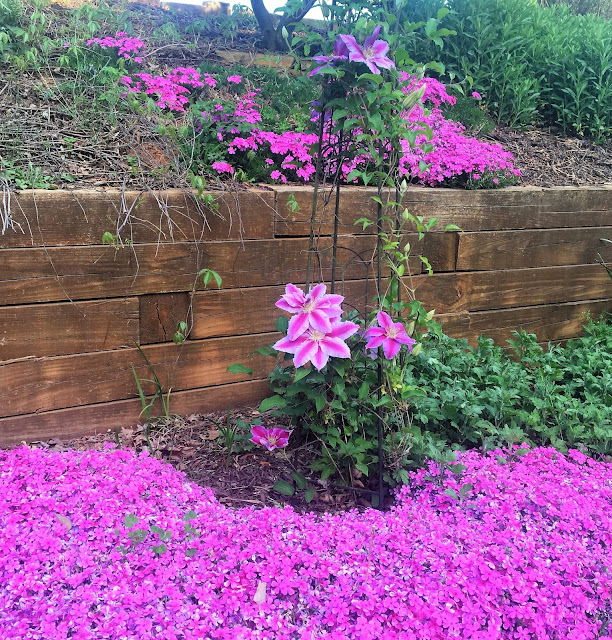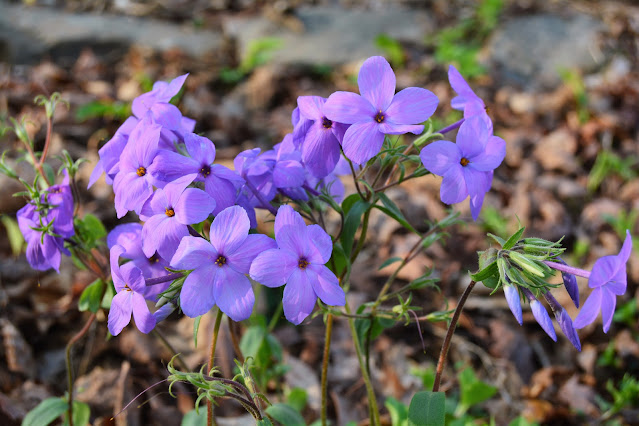Spring Blooming Phlox for Sun & Shade
It's phlox season! Two of my spring favorites are stolonifera and divaricata; one for sun and one for shade. These easy to care for perennials provide lots of color and support pollinators so they get lots of love in our garden. Creeping phlox (phlox stolonifera) is a native groundcover that creates a carpet of color in March and April and is a magnet for our early emerging butterflies and hummingbird moths.
 |
| phlox subulata flowing down slope near our patio |
 |
| Another angle on the otherside of the patio |
Phlox stolonifera is my go to plant on hillsides, of which we have many. The low growing perennial aides in erosion control and once established creates a flowing mass that spills down the slope.
 |
| phlox stolonifera with Eryngium yuccifolium (foreground) and Itea virginica (background) |
A quick walk around our garden in spring and you will see how often I use this plant in our landscape. In the front garden it softens the hardscape while preventing soil and mulch from falling on the stairs, especially during heavy rains.
 |
| Fothergilla 'Mt. Airy' with phlox stolonifera |
A wider angle of the same flower bed reveales Fothergilla 'Mt. Airy' just beginning to bloom accenting the ground phlox. In the above photo, follow the path along the side of the house to see more phlox in a bed in the back garden.
Planting this showy groundcover with other spring blooming perennials, trees or shrubs will create more drama in the landscape. Above it is planted near Serviceberry (Amelanchier arborea) and blue eyed grass (Sisyrinchium angustifolium) that will soon be covered in dainly blue flowers.
An unknown species of Clematis growing up the tuteur picks up the same hot pink as the phlox, which was a happy accident because I am usually not that matchy matchy in my garden design.
Just as the daffodils finish blooming the phlox and eastern columbine (Aquilegia canadensis) welcome pollinators in this bed that runs along the driveway.
Here, the phlox is partnered with more columbine as well as several hellebore species that provide color in late winter to the hedgerow above the wood retaining wall.
Besides being a fabulous ground cover the flowers support our native long-tongued insects emerging from their overwintering state.
 |
| Nessus sphinx moth visiting creeping phlox |
 |
| Eastern Tiger Swallowtail on creeping phlox |
In our shade garden, phlox divaricata is the star. The flowers dance in the evening light as it filters through the woods.
This shallow rooted perennial (divaricata = spreading habit) is a fabulous ground cover that bulbs can grow through providing a spring woodland show. They would pair with virginia bluebell (Mertensia virginica), trout lily (Erythronium umbilicatum) and wood poppy (Stylophorum diphyllum) in an early season shade meadow. Or in a shade garden with ferns and spring ephemerals.
The tubular blue flowers have five petals and require cross pollination to produce seed. They too are frequented by long-tongued insects such as butterflies, sphynx moths and bumblebees.
The wood phlox are sharing this bed with a volunteer Euonymus americanus and white violas.
This area is heavily mulched with leaves so weeds are not a problem. Deer and rabbits also don't bother them although according to Lady Bird Johnson Wildflower Center the roots of phlox divaricata are appreciated by rabbits and voles, both of which are abundant on our property.
Are you celebrating these fabulous phlox? If not, find a place to add them to your garden. You won't regret it.









.png)
